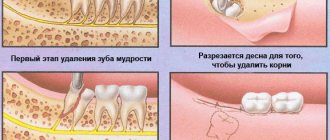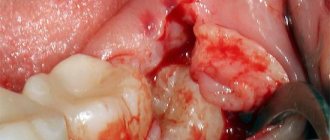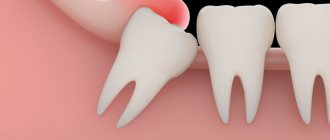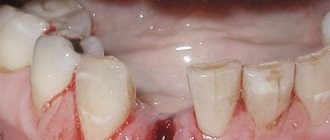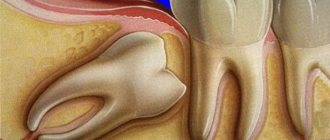From this article you will learn:
- symptoms of wisdom tooth growth,
- what to do if your wisdom tooth is cutting out and your gums are swollen or you have a fever.
The article was written by a dental surgeon with more than 19 years of experience.
The wisdom tooth is located at the very end of the dentition, and therefore it is often called the “figure eight” (the serial numbers of the teeth are assigned starting from the central incisors). Thus, a person has only 4 wisdom teeth - one on each side of the upper and lower jaw. No other teeth cause us so much discomfort and pain when they begin to erupt. It most often occurs between the ages of 18 and 21, but can occur at 14 or 40 years of age.
It is interesting that the incidence of difficult wisdom teeth eruption increases with each generation. This is due to the chewing load, and the fact that people are increasingly eating too soft, overly processed food. As a result, the chewing load that the teeth transmit to the bone tissue of the jaws turns out to be insufficient, which leads to a gradual decrease in the mass and volume of the bone, including a decrease in the length of the lower jaw. As a result, with the same number of teeth, we have less and less space for their eruption.
How a wisdom tooth is cut: photo, x-ray
As a result, competition arises between teeth for a place in the dentition, and those teeth that erupt last are in the most disadvantageous position. Most people are familiar with the fact that when a wisdom tooth is cut, the symptoms of eruption and associated inflammation can cause a lot of inconvenience. And this is not only pain, suppuration or just felt discomfort. If there is not enough space in the dentition, the erupting wisdom teeth put pressure on the teeth in front, moving them to the center of the dentition. It is for this reason that many patients experience crowding of their front teeth over time.
A few facts about wisdom teeth –
Wisdom teeth are the only teeth in which the formation of germs does not occur during intrauterine development, but already in a born child at the age of 4-5 years.
In this case, the crown part of the wisdom tooth completes its formation at the age of 12 years, and the end of the formation of the roots usually occurs no earlier than 24 years. On the x-ray you can see a wisdom tooth whose roots have not yet completed formation (compare with the roots of the 7th tooth in front). Well, the last feature that we talked about above is that the eruption of all other teeth in the permanent dentition occurs in the period from 6 to 13 years, and only the eighth teeth usually begin to erupt no earlier than 18-21 years.
Symptoms of wisdom teeth erupting
Features of growth
Symptoms of the appearance of wisdom teeth
If your wisdom tooth grows incorrectly
How to relieve pain when wisdom teeth erupt
If a wisdom tooth grows during pregnancy
Eights, also known as wisdom teeth or third molars, are the most “problematic” teeth. They are the last to erupt, from about 16 to 30 years of age. At this age, the jaw is already formed, so the eights simply do not have enough space in the dentition, so when they appear, they begin to cause discomfort.
Table of contents
- At what age are eights cut?
- Why is the wisdom tooth called that way?
- How long does it take for a number eight to grow?
- What is a wisdom tooth for?
- When are eights removed?
- Tooth extraction problems
- Is there pain when removing figure eights?
- What measures to take if you have dental problems during pregnancy?
- Complications during the eruption of wisdom teeth
- Actions prohibited for wisdom tooth pain
- What to do if the gums around a wisdom tooth are inflamed
- Is it possible to treat eights with folk remedies?
The eights in human teeth are located at the edges and this is what makes them too problematic. It is worth noting that, unlike other teeth, these grow only many years after the others have appeared, and in some cases the immediate process of their growth causes severe pain and requires their immediate removal. Statistics show the fact that not every person can always have a wisdom tooth, since during the development of the human race significant transformations took place and the jaw of modern people is 12 mm smaller relative to their ancestors, which is caused by eating softer and thermally processed food, which reduces the load on the jaw . Everyone has the germ of a wisdom tooth, but whether they grow or not depends only on physiology.
At what age are eights cut?
The replacement of a row of milk teeth with molars is carried out from 6-12 years. The eruption of wisdom teeth may not begin until the age of 21, but if they have not shown any signs of their existence before the age of 27, then it is quite possible that they will not grow at all. In medical practice, there are cases where a wisdom tooth can erupt at the age of 40, but such cases are very rare.
Why was the wisdom tooth called that way?
As already mentioned, teeth erupt before the age of 7 years, and wisdom teeth in the period 18-27 years. It is at this age that the formation of organs ends and the aging of the body actually begins. In other words, wisdom teeth begin to erupt at a time when the body has reached its maturity, which is how they get their name.
How long does it take for a number eight to grow?
How long the figure eight will grow depends on several factors. Initially, it depends on the size of the jaw a person has, as well as whether there is free space for the tooth to be normally located in its rightful place. If the jaw is too small, and there is simply no additional space for wisdom teeth to grow, then they will begin to gradually move neighboring teeth, which can last for several years, and will also cause a distortion in the evenness of the teeth.
What is a wisdom tooth needed for?
Nature has thought out each organism so carefully that each of its components, and in particular the wisdom tooth, cannot be superfluous. Some experts even call wisdom teeth rudiments, but they are often very useful in old age. It is on wisdom teeth that prosthetic bridges are placed in order to install a dental crown when other chewing teeth are removed. For this reason, dentists do not recommend immediately removing a wisdom tooth, since a banal 2-minute process can cost serious problems in the future.
When are eights removed?
Is it worth it or not to remove a wisdom tooth? This is the question that dentists are often asked by those who have encountered them. Wisdom tooth removal is the most standard surgical procedure, and to perform it, certain indicators are needed. Wisdom tooth removal is quite possible if:
- the presence of ratification of wisdom teeth, or in other words, incorrect placement of the figure eight, which can cause movement of other teeth during eruption;
- damage to wisdom teeth by caries, as this will affect the health of the root system and can affect neighboring teeth, but it is not always possible to fill the figure eight correctly and without mistakes;
- partial eruption of the wisdom tooth, which may occur due to the presence of an inflammatory process in the gum cavity;
- manifestation of pain in the trigeminal nerve;
- detection of a cyst in the cavity of the lower jaw;
- the presence of pain in the wisdom tooth, especially if it occurs when eating food;
- injury to the oral cavity if the wisdom tooth is positioned incorrectly.
Tooth extraction problems
The process of removing tooth 8 in a row can only be carried out by a qualified dental surgeon, after an x-ray. Almost always, tearing out a figure eight is painful, since its location will take a long time to heal and complications may develop. Pain, as a rule, after removal becomes the cause of the formation of alveolitis or, in other words, an inflammatory process in the socket.
Important: Ideally, the hole is covered with blood clots, which prevent the penetration of bacteria and food debris into it, therefore it is strictly forbidden to rinse the mouth after surgery. When washing out clots, you may encounter not just pain, but the formation of an infection, which will require additional surgical intervention and a long-term solution. At first, after the removal of a wisdom tooth, you may feel numbness in the cavity of the tongue, lips and even chin. If the numbness does not subside after a week, then a second visit to the doctor is required.
Is there pain when removing figure eights?
Naturally, tooth extraction is not the easiest or simplest process, and therefore many people are very worried about this and simply avoid meeting with a doctor. The operation is performed using local anesthesia. In other words, a strong painkiller is given, the type of which is discussed individually with the patient. Difficulties may arise when directly removing the figure eight, since the inconvenient location does not allow you to get close and quickly pull it out. Whether there will be severe pain after removal depends on:
- how the tooth is positioned;
- features of the root system;
- whether there are complications such as purulent inflammation, cyst or the like;
- human sensitivity threshold.
What measures should you take if you have dental problems during pregnancy?
Pregnancy is a very difficult and anxious period for every woman, but it is accompanied by a decrease in the level of calcium in the body, which primarily affects the teeth, their quality, strength and wear resistance. It is very important that no woman is immune from the fact that a wisdom tooth may start cutting or hurting.
Important: Gynecologists categorically prohibit dental treatment, regardless of their location, using anesthesia, as this has a detrimental effect on the development of the fetus. If there is a strong need, it is permissible to carry out removal or treatment only after reaching 22 weeks, since it is possible to use painkillers without harm to the baby.
Complications during the eruption of wisdom teeth
Unlike teething other teeth, eights can bring a lot of problems.
The tissue in the gum cavity near the tooth becomes inflamed. This most often manifests itself in the form of a tubercle covered with mucous membrane around the location of the figure eight. This is the so-called hood, which is injured with every meal, irritating the receptors in the mouth and thereby causing severe pain. This contributes to the formation of an inflammatory process and even the occurrence of infection with suppuration.
Sometimes it may seem that there is pain in the cheek, throat and tonsils, but it is the wisdom tooth that spreads these sensations. Only a specialist can identify and diagnose this problem, and therefore a doctor’s consultation is required to rule out the possibility of a cold.
Important: When the figure eight becomes inflamed, the whole body begins to suffer. In other words, the body temperature may rise, pain in the head, throat and even the cervical region may occur. The formation of swelling of the gums is allowed.
Actions prohibited for wisdom tooth pain
Experts do not recommend doing dental treatment on your own, or doing the following:
- warming the cheek, rinsing with hot water and applying a heating pad, as this can lead to a worsening of the condition and the occurrence of suppuration of the inflamed tissue;
- applying painkillers to the inflammation around the figure eight, which contributes to the appearance of ulcers on the tongue cavity, without relieving the pain;
- using advice from relatives, since you first need to find out the cause of pain and inflammation, and only then take measures to eliminate the problem.
What to do if the gums around the wisdom tooth are inflamed?
Intervention in the treatment of wisdom teeth on your own can cause a worsening of the condition, for example, fever, unbearable pain and similar problems. What to do if symptoms associated with the figure eight appear?
- Immediate contact with a dentist is required.
- An x-ray or, preferably, an ultrasound is required.
Important: When making a diagnosis such as the presence of suppuration, regardless of what stage of development, an immediate autopsy is required, as well as treatment and painkillers. Further development depends on the degree of complexity of the problem and on the medical indicators of the patient’s body.
Is it possible to treat eights with folk remedies?
To reduce pain during teething, you can use medications or folk remedies, but only with caution so as not to cause an allergic reaction and other serious consequences.
- The simplest method is considered to be the usual rinsing with a solution based on herbs such as sage, chamomile, oak bark or ordinary soda. It is permissible to lubricate the gums with sea buckthorn oil.
- Melissa officinalis, or to be more precise, a solution based on it is prepared immediately before use and should be stored in the refrigerator. 2 tbsp. pour 0.5 liters of boiling water, infuse for 4 hours and use for rinsing. The procedure is carried out 4 times every 24 hours, after which the composition is brewed again.
- You can boil chicory root and rinse your mouth with it. The peculiarity of the root is the presence of anti-inflammatory and analgesic effects. 250 ml of boiling water should be poured into a container with 1 tbsp. chicory root, previously thoroughly chopped. Boil the composition for 5 minutes. Next, you need to let it brew for 60 minutes, strain and rinse every 2 hours.
Important: If any problems arise with wisdom teeth, for example, pain, swelling, or even more so deformation of the teeth during eruption, you should immediately contact a dentist, a qualified specialist, for examination, consultation and taking certain measures to eliminate the problem.
Features of growth
Unlike molars, eights do not have milk precursors in their buds. They erupt after the permanent teeth appear. You can see how this happens in the picture.
Eruption of wisdom teeth depending on age
When molars emerge, a crown forms on the third molar. Then, after a few years, roots begin to grow. Only after the wisdom tooth inside has fully formed does it begin to erupt.
Appearance time and quantity
They can erupt at 18, 25, 30, 40 years old, or they may be absent from a person’s jaws throughout his entire life. Usually there are four of them (two at the top and two at the bottom). This is the number that is considered the norm, since together with the rest of its “brothers” it amounts to 32 teeth. However, there may be more wisdom teeth. Some people develop one or two ninth teeth over time, while others
the number of teeth in this group can reach 10! In general, the presence or absence of wisdom teeth, the time of their appearance and the number depend, first of all, on hereditary factors, as well as on the size and shape of the jaws.
It is also interesting that by the age of three, the rudiments of molars begin to form in a person. It is during this period of time that the picture becomes clearer with the further formation of at least one wisdom tooth and the total number of such already embedded teeth. And by about 12 years of age, when all the other molars have already erupted and play an important role in chewing food, the formation of the crown of the wisdom tooth is nearing completion.
Difficulties that arise during the appearance of eights
| Pericoronitis. This is an inflammation of the gum tissue surrounding the visible part of the tooth. If you delay a visit to the dentist, purulent inflammation (abscess or phlegmon) may appear. Manifestation of pericoronitis: severe pain when opening the mouth or while eating, bad breath. In most cases, this disease occurs in 80% of people when the lower eights erupt. |
| Dystopia of the tooth. This is an incorrect position of the tooth in the jaw, that is, the eights can be located horizontally or at an angle. Over time, they begin to push against neighboring ones, leading to their destruction. Most often, dystopia is inherited. To avoid complications, it is recommended to remove dystopic wisdom teeth. |
| Retention. This is when the tooth has partially erupted or not erupted at all. If the tooth does not hurt and does not interfere with its neighbors, then it can be left. Conversely, if a tooth causes unbearable pain and destroys the roots of an adjacent tooth, then it should be removed. |
| Hidden caries . An affected wisdom tooth can cause caries to spread to other teeth; in this case, it is better to remove the tooth. |
The main causes of pain
Painful symptoms from wisdom teeth are caused by the anatomical features of the upper and lower jaw, which are already fully formed in a person at the age of 17-25.
As the figure eight begins to grow, it puts pressure on neighboring teeth, bone and soft tissue. The growth process can last for months and even years, so pain manifestations are temporary, periodically fading and exacerbating.
The pain of tooth 8 can be provoked not only by its growth or anatomically incorrect position, but also by the presence of various pathologies, for example, caries, pulpitis, periodontitis or a wide range of infectious diseases. Note! The lack of timely professional help can provoke a worsening of the situation, which will result in the need to remove the diseased tooth and treat complications.
Symptoms of the appearance of wisdom teeth
As a rule, the eruption of figure eights is accompanied by certain symptoms.
Pain in the gums.
It can be different: aching, pulsating or sharp. This all lasts for several days, or maybe the entire time the tooth grows.
Swelling and swelling.
Sometimes during the period of teething, swelling or swelling appears on the gums. In case of severe swelling, which is accompanied by severe pain and fever, it is recommended to consult a doctor.
Increased body temperature.
An abnormally growing wisdom tooth may be accompanied by an increase in temperature. If the values do not go beyond 38 degrees, there is no need to worry - this is the norm. If the readings are higher, you should make an appointment with your dentist.
A sore throat.
Occurs during an infectious process. During teething, the mucous membrane is very vulnerable, so during this period it is necessary to devote more time to hygiene in order to avoid infection.
What pathologies cause problems?
There are several common situations that can cause severe pain and the need for your tooth to be removed. These include:
- Incorrect position inside the gum. There can be a lot of location options here. For some clients, teeth grow sideways, while for others, the lights begin to put extreme pressure on adjacent units, potentially even causing noticeable misalignment. The biggest risk in this case is the potential appearance of a malignant tumor, which will have to be operated on. If a wisdom tooth begins to grow crooked, it can no longer be corrected. The only option is deletion.
- Damage to a neighboring unit. In this case, pain will arise not only from the outermost molar, but also from the gradual destruction of the tooth itself. The risks in such a situation are great - it may be necessary to remove both units. We strongly recommend not to let this happen and consult a doctor in advance.
- Inflammation of the gums. A number of patients also experience a spread of the inflammatory process. The reason is the very location of the third molars and their great distance from the rest of the teeth. Inflammation in the gums is dangerous for the entire human body. It can develop into suppuration, the development of facial asymmetry, and general intoxication of the body.
The process of teething itself can also cause discomfort, even if the figure eight grows correctly. Since the dentition is completely renewed at an early age, we often simply forget how unpleasant it is.
If your wisdom tooth grows incorrectly
Complications often arise when figure eights are cut out incorrectly.
- Flux is a purulent inflammation of the periosteum.
- Cellulitis is a purulent inflammation, which is accompanied by an increase in temperature to 39 degrees and swelling of the face.
- Osteomyelitis is an inflammatory disease that affects bone tissue. Main symptoms: fever, nausea, vomiting, diarrhea.
If unpleasant symptoms occur, it is recommended to make an appointment with a dentist-surgeon. He will assess the condition of the tooth and help avoid the risks of complications. You can make an appointment with our specialists by calling: 220-86-30.
Impacted third molars
- Lack of space leads to abnormal placement of the tooth in the jaw arch. Impacted teeth can grow towards the cheek and constantly injure its mucous membrane.
- In the absence of an antagonist in the opposite jaw, they cause serious malocclusion, ultimately leading to imbalance of the masticatory muscles, pinched nerve endings, dysfunction of the temporomandibular joint and even neurological disorder.
- A tooth that does not come out of the bone often provokes the formation of a follicular cyst, which does not manifest itself for a long time. This is explained by the presence of remnants of a follicle around it, the cells of which, for as yet unknown reasons, begin to multiply. The roots of the adjacent molar often get into the lumen of the cyst. This leads to necrosis of their pulp and necessitates the treatment of pulpitis and depulpation of the tooth.
- The third molar can put pressure on the roots of the second, causing headaches, soreness in the ear or throat.
How to relieve pain when wisdom teeth erupt
The easiest way to get rid of unpleasant symptoms is to take over-the-counter painkillers.
- To relieve pain and fever: Nurofen, Ibuprofen, Nimesulide, Paracetamol.
- To eliminate pain: “Spazmalgon”, “Ketanov”, “Analgin”, “Pentalgin”, etc.
- Antiseptics to relieve symptoms and prevent complications: Miramistin, Chlorhexidine, Furacilin, etc.
- For local pain relief: “Kamistad”, “Kalgel”, “Cholisal”.
You can use folk remedies.
- Rinse solution made from salt and soda. Dissolve 1 teaspoon of salt and soda in a glass of warm water. It is recommended to rinse your mouth no more than 3 times a day.
- Rinse solution made from propolis tincture. Stir 7-8 drops of tincture in a glass of warm water. The solution is also a natural antiseptic.
- Cold compress. Under no circumstances should it be hot - heat may cause inflammation.
- Sage decoction. Pour 1 tablespoon of sage into a glass of boiling water, leave for an hour, strain. You can rinse until relief occurs.
Relieving pain during wisdom tooth eruption is only a short-term solution. A competent consultation with a doctor will help you cope with pain and possible complications.
Post-operative care
After wisdom tooth removal, many patients experience severe pain for several days. Painful sensations affect not only the jaw, but also spread to the head, throat, and ear. You can take painkillers for three days, but if the pain does not go away, you should seek help from a specialist.
To alleviate the condition after surgery, you must follow these recommendations:
- When a wisdom tooth is removed, it is forbidden to touch the site of its removal with your tongue or fingers for 4 hours after the operation.
- After removing the “eight”, you need to apply a cold compress to your cheek every 20 minutes throughout the day. Such actions will reduce the intensity of pain and relieve inflammation.
- After the operation, it is forbidden to eat for the next 3 hours, and during the day, avoid drinking alcohol and stop smoking.
- Avoid excessive activity of facial expressions for several days.
In rare cases, a wisdom tooth after removal can cause the development of sore throat and inflammation of the tonsils. For such complications, special therapy is required.
This article is for informational purposes only, please consult your doctor for details!
Other publications:
- How to brush your teeth correctly?
- The period of changing teeth in a baby: diagram, approximate timing of the process of tooth loss in babies, advice from a doctor on caring for the oral cavity.
If a wisdom tooth grows during pregnancy
If the eights began to grow during pregnancy, then the expectant mother should make an appointment with a doctor. This will help protect the baby from negative consequences and significantly improve the well-being of the pregnant woman. If there are unpleasant symptoms (improper position, pain, inflammation), the dentist may recommend removing the wisdom tooth. In this case, it is better to do this in the second trimester, when the operation will not harm either the mother or the child. At other times, it is not recommended to carry out any procedures unless there is a threat to the health of the woman and baby.
Ways to fight
You can reduce pain symptoms before going to the doctor. To do this, gently massage the problem area with a piece of ice. Before the procedure, hands are washed with soap and disinfected. The movements are performed in a circle. The procedure helps relieve pain for 15-30 minutes without harm to health.
Do not intensively rub ice on the inflamed area. Otherwise, you can damage the hood of the wisdom tooth and cause increased bleeding and swelling. Massage using ice is performed for 5 minutes 3-5 times a day.
Before rubbing, nails must be trimmed to prevent injury to the mucous membranes and the spread of infection throughout the oral cavity. During your examination, your dentist will recommend a suitable anti-inflammatory ointment to relieve swelling in your gums and palate. Instead of an ice massage, mint candies or ice cream are dissolved. The products temporarily reduce the sensitivity of the problem area.
To properly grind food, it is not necessary to have a full row in your mouth. 28 teeth are enough for high-quality chewing of food, so when the first signs of pain in the eights appear, you should immediately visit a doctor so that he can assess the situation. It is advisable to insist on preserving the unit only if a person is diagnosed with multiple absences of teeth in a row. In this case, figure eights can be used as a basis for prosthetics. In this case, it is better to treat the elements, even if they are affected by caries or pulpitis. In other situations, it would be more advisable to remove third molars, since the consequences of their improper eruption are much more dangerous than the potential benefits of their presence in the row.
Periodontal diseases
Difficult access to the third molars does not allow them to be thoroughly cleaned of soft plaque, which very quickly turns into hard dental deposits. If the patient does not resort to professional teeth cleaning, the periodontal tissues surrounding the tooth will become inflamed - periodontitis will occur. This disease practically does not manifest itself for a very long time, and if left untreated, the infection spreads to the bone tissue, provoking the appearance of osteoperiostitis, better known as dental gumboil.

